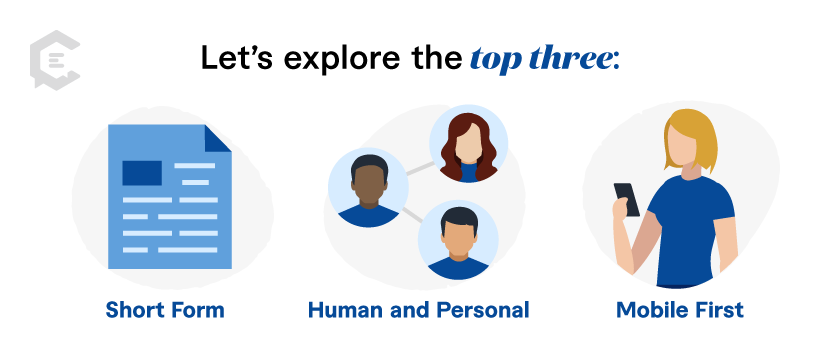If you know how to develop a content creation strategy, you realize it requires honest assessments of your current state of business and considerations of where you want to be in the future.
It’s not about the buzz du jour or fly-by-night industry tactics.
It’s about sharing your brand message with your customers, so you win today and win ongoingly. With an effective content marketing plan, you can make that happen.
Perform a Google search on “content strategy.” You’ll get millions of results offering tips, ideas, and templates to help you get started.
While some of these pages provide sound advice and guidance, remember to evaluate your organization’s unique circumstances before taking action. What are your biggest challenges with content? It is important to take the time to consider some critical questions before you even begin making a list of blog topics.
Why?
Content created for the sake of content or to meet some self-imposed publishing schedule isn’t enough. Your content needs to serve your business by supporting your long-term goals. In return, your organization has to support content strategy with executive buy-in, budgets, and resources. And let’s not forget the customers. Your content has to meet the customer’s needs at each phase of the buyer journey.
Careful thought must go into your content creation strategy to be effective. So, start with the big picture questions first and ensure your efforts align with your brand’s goals.
To help you develop your strategy, we’ve put together a list of 25 questions to consider as you build your content plans and make your content vision come to life.
Want to skip ahead? Read our 25 Questions to Elevate Your Content Strategy video series and workbook now.
Why is creating content important?
It’s not rocket science: Content marketing brings businesses and customers closer together.
That’s how businesses can win their target audience’s trust and convert them into paying customers.
Content also serves as the primary building block of a brand’s digital marketing strategy. Businesses can reach a wider audience by promoting on digital channels like social media, emails, blogs, and syndication websites.
Developing a solid content strategy, which includes content creation, is crucial to accomplishing goals.
What’s new in content marketing?
Content marketing has come a long way from article submission sites and self-hosted blogging.
To excel in the modern marketing landscape, brands need to go well above and beyond traditional text-based content to excel in the modern marketing landscape.
Sure, high-quality articles still play a significant role in the marketing of emerging brands. But if they want to thrive, they need to update their strategy to match the technologies and preferences in content consumption.
So, what are the top content marketing trends brands need to know?
-
Short-form content
TikTok videos, Instagram Reels, YouTube Shorts — Millennials and Gen Zers adopted a liking for bite-sized content.
The need for instant gratification, be it for information or entertainment, is something brands can no longer ignore. And, in this age of digital immediacy, short-form content can be their most effective tool for maintaining a loud online presence.
-
Human and personal brand voice
More businesses use a humanized voice to be approachable, relatable, and connected with their audience. It makes long-form, technical content less intimidating and boring to read — not to mention a consistent and personal voice can make any brand more recognizable.
-
Mobile-first content marketing
Optimizing content for mobile users should no longer be an afterthought.
With more users browsing the web on smartphones and tablets, even search engines like Google advocate for a mobile-first approach to content marketing. You should write, format, and optimize your content for mobile devices first, then desktop browsers.
Other noteworthy content marketing trends (2024)
- Blogs, images, infographics, and videos are the top four content marketing formats
- Podcasts continue to be relevant for content consumption on the go
- Successful content marketers align their messaging with their audience’s values (equality, diversity, environmental awareness, etc.)
25 Content Questions When Creating Your Content Strategy
As we move further into the year, it’s time to take another look at your content marketing.
Here are 25 important questions that every brand should answer to update their content strategy:
Want to skip ahead to our workbook and video series? Here you go: 25 Questions to Elevate Your Content Strategy.
Start by defining your goals
Let’s start with big-picture questions to develop your content creation strategy. As you start to review these questions, download our companion questionnaire to capture your answers.
Your content must support the organizational goals and objectives. Otherwise, what’s the point?
Setting goals for the next 6-12 makes decision-making easier and progress consistent. Whenever choices present themselves, choose the option that contributes to these long-term goals.
After you document the answer to question #1, start developing a list of objectives and associated Key Performance Indicators (KPIs).
Be specific in defining your KPIs so you can effectively measure your progress.
Some examples of KPIs for content marketing include:
- Social media follower growth
- Social media engagement (likes, shares, views, etc.)
- Customer acquisition cost
- Click-through rate
- Brand market share
KPIs pertain to data tied to specific business goals. On the other hand, metrics are more basic and can tell you a lot about content performance on a page level.
Some examples of metrics for content marketing are:
- Page scroll depth
- Average session duration
- Monthly traffic
You need a good mix of text, video, and images to capture your audience’s attention.
As Heidi Cohen points out, “We live in a 4+ screen world” where many people use two or more screens. Do you have content that meets your audience’s device and format preferences?
It’s a good idea to go back to your goals and brainstorm content types that will help you reach them.
Learn what competitors are doing successfully from a tactical standpoint, and emulate those efforts when it makes sense. But make your messaging and strategy uniquely yours.
Study the competition and devise ways to differentiate your brand through your content. Apart from directly observing your top competitors’ channels, use competitor research tools like:
Your content must be both easy to read and optimized for search engines. As more people begin to search by voice, you need to pay more attention to conversational SEO.
Most people searching by voice have local intent (“restaurants near me”). However, as reliance on technology grows, more people will search by voice.
Even global B2B companies will benefit from voice search as more people adopt a voice-first mentality.
Getting to know your target audience
Does this seem like a no-brainer? You know your target customers based on your gut or your everyday encounters with buyers, right? But that’s merely a glimpse—and it could be flawed. So start by documenting the big picture of who your ideal customers are.
Demographics include information such as age, income, education level, etc. This is crucial to determining the type of content you need, the questions it should answer, along with the language and imagery you should use.
What resonates with a millennial may not mean as much to a Gen Xer or Baby Boomer.
Marketo has a great cheat sheet to help you create your buyer personas.
Psychographics are the attitudes, aspirations, and other “psychological” information about your target audience.
These insights may be more complex to gather than demographic data, but the effort is worth it.
If your persona is typically a positive and upbeat person, fear tactics and somber writing won’t win them over.
HubSpot offers an excellent beginner’s guide on using psychographics in your marketing.
If your customers love video content and spend a lot of time on YouTube, you need to create video content.
If they devour articles on industry trade websites, you need to get a guest post on the site or curate that content on your site and social platforms.
It should be easy to identify what your market prefers in terms of content consumption through simple observation. If you want suggestions, run surveys on social media or through tools like Google Forms.
If you create content for B2B audiences, you may need to consider industry verticals. What’s true of a buyer in consumer packaged goods may not be true for a buyer in the automotive industry.
Identify unique descriptors for buyer personas in your vertical. Doing so lets you create content tailored to their needs.
Ready to get started? Access our 25 Questions to Elevate Your Content Strategy video series and workbook.
Preparing for content production
Help your team create content that is consistent with the brand values, style, and tone. Publish your brand style guide and ensure everyone understands why brand consistency is so important.
The first order of business is to decide what to include in your style guidelines. Next up, you need to plan how it’ll be distributed throughout your content team.
Generally, more people are involved in complex sales. Your salespeople need content that resonates with the different influencers and decision-makers who will ultimately make or break the deal.
Work more closely with reps to ensure they have content that enables them to move prospects smoothly through each stage sales process.
Figure out who needs to be involved in the approval process. One misstep could, at best, ruffle some feathers. At worst, it could get you fired or in compliance hot water if you’re in a regulated industry.
Personas are helpful; however, customers don’t often purchase based on what the “average customer” does.
Create content that helps prospects “hire” the right product to complete the “job to be done.”
What typically gets in the way of a job your customer needs to finish, and how can your content facilitate the decision to “hire” your brand?
Great content requires more than a couple of marketers. Even with a jack-of-all-trades who’s pretty talented in several key areas, you will need additional support for writing, design, and promotion.
Here’s where the rubber meets the road—the moment you discover how much of this you will be able to execute.
If your plan is realistic and you can forecast an ROI, you will probably have fewer obstacles getting your budget approved than someone who didn’t do their homework. If you have to ask for more money, make sure you have the data to back up your plan.
Streamlining content creation and promotion
Formats are platform-specific, like listicles, roundups, “how-to” guides (for blogs), image quotes, and videos (for social media).
Play to your strengths, but also consider your goals and your users’ preferences.
A few tools that can help you with your content efforts include editorial calendar software or templates, project management tools, analytics, mind-mapping tools, templates, tools for visual storytelling, pre-launch checklists for each content type, and so on. ClearVoice comes complete with strategy, project management, and publisher tools to help simplify the process.
Tools to consider for distribution and promotion include social media dashboards, email marketing programs, employee advocacy, social selling solutions, and influencer marketing platforms.
The best way to ensure a plan is executed correctly is to communicate the plan and hold people accountable.
Most, if not all, content calendar tools allow multiple users to collaborate on projects. Use this feature to keep everyone in your content marketing team on the same page.
Each piece of content will have a home; your website, blog, YouTube, SlideShare, etc.
Each will also have its own distribution/promotion efforts: social sharing, paid discovery, and email marketing.
There may even be individuals outside your marketing team responsible for amplifying content, such as employee advocates, social sellers, and outside influencers.
Don’t let evergreen content go to waste.
Create a schedule for resurfacing and sharing this content type. Search Engine Watch explains why evergreen content is so important.
You should also take the time to re-optimize and refresh your content to ensure it remains relevant and updated. For example, replace the data and statistics you referenced several years back with something more recent.
Pay close attention to the screenshots you took on apps or other online tools. Chances are, the software is already updated and now has a totally new look.
The takeaway is they allow you to reap the benefits of content marketing for several years.
Tracking content performance
Look for collaboration tools that can help your team track deadlines and the productivity of individual members. Trello, for example, provides teams with a visual, Kanban-style project manager where they can share files, track deadlines, assign tasks, and communicate via comments.
At the same time, use platforms like Google Analytics to track the performance of published content over time.
Identify which team members and executives need access to reports, and then determine what level of data they need and how often they need it.
Take note that most platforms feature automated report generation. The sooner you answer this question, the earlier you can configure this automation.
Select metrics like bounce rate, time on page, actions after viewing a page, etc., to help you evaluate your current content’s effectiveness.
Use the content tracking tools you specified in question #23 to monitor these metrics.
If your results improve, double down on your strategy. Otherwise, revert to your original strategy or try a different approach. A/B or split testing can help speed up the trial-and-error process in determining the best content for your brand.
How to develop a content strategy for today and beyond
You’ve taken the time to explore the significant issues that can make or break your content strategy, but the work doesn’t stop there.
Information without action is as useless as no information at all.
Start organizing your findings into the next steps that make sense for your organization based on your content marketing maturity level.
Developing a content strategy for beginners
In the early stages of your content marketing adoption, you will face several obstacles.
Your primary objective in this phase of your journey is to establish a content culture.
Use your findings to the questions above to help management and other departments understand the role content can play in improving customer service and loyalty, generating leads, increasing sales, and improving the organization’s visibility in your industry. Help others see your vision and feel like an integral part of making it happen.
Also, make participation a privilege instead of a chore, especially if you are a solo marketer in a small-to-mid-sized company.
You can’t do this alone.
You need to sell the vision.
Suggestions for this phase revolve around establishing a culture of content:
- Gain executive buy-in and budget.
- Share the vision with other departments.
- Sell others on being part of the process.
- Develop buyer personas to ensure your content resonates with your potential customers.
- Establish a manageable content plan (e.g., basic SEO, blogging, email, and social media).
Intermediate content creation strategy
If you have reached this phase, you likely have a blog, participation from subject matter experts, a social media presence, and reporting.
Maybe you have experimented with other content forms like videos, infographics, ebooks or white papers, and podcasts. However, things could still use a little fine-tuning. Focus on your persona-related and content audit questions above to make improvements.
If your organization is in this phase, spend time prioritizing the next steps:
- Refine your buyer personas for a more in-depth picture of your ideal customer.
- Audit your existing content and ask if it meets the ideal customer’s needs. (your new, in-depth persona)
- Determine if you have content topics and formats that speak to buyers at each buyer journey stage.
- Experiment with new content promotion and distribution methods to reach more qualified audiences. (remarketing or paid social media, for example)
Advanced content creation strategy
If your organization has reached the advanced stage, congratulations!
You’ve already done the hard work to build a culture of content and perfect your messaging and reach methods to inform, educate and engage target audiences.
Just don’t get too comfortable.
You can never stop learning and growing.
Suggestions for companies at this stage involve next-level content thinking:
- Study new trends in online marketing, including things like voice skills for Alexa or Google Home, virtual reality, and augmented reality. Consider the implications these new content forms will have on your SEO.
- Experiment with machine learning and artificial intelligence platforms that can help you personalize content for each unique visitor.
- Treat your content site as a media property that is as valuable as the product or service itself, and ask for the budget and resources that the effort deserves. Be ready to prove ROI when you make the ask.
Additional content strategy questions to ask
You can never know too much when it comes to something as complex and significant as content marketing. To wrap things up, here are a handful of other questions that will help you shape your content marketing strategy:
What are the 3 components of content strategy?
A successful content strategy has three core components: brand focus, user experience, and content distribution. By the time you finish answering all the questions above, you’re ready for all three.
What are the 5 steps of developing content strategy?
Different sources will tell you a slightly different sequence of steps in developing a content strategy. However, it almost always involves five things: goal setting, audience research, content ideation/research, content creation and distribution, and performance tracking.
What are examples of content strategy?
Different content strategies can be used for the accomplishment of marketing goals. Websites may give unique names to these strategies, but most of them pertain to email drip campaigns, blogger outreach campaigns, ego-bait articles, and lead nurturing campaigns.
What is a content strategy framework?
A content strategy framework is a complete, documented, and organized plan for content marketing. It covers your target audience, content marketing goals, content creation workflows, promotion processes, and content analysis.
Using our content creation plan template
Ready to build your very own content strategy framework? We created a content creation plan questionnaire to help you get started on creating or updating your content strategy.
Develop a successful content marketing strategy today
Building a winning content marketing strategy takes time, even more so when it’s time to execute the strategy.
Ensuring a steady supply of content, in particular, can be overwhelming without a content team that can consistently deliver quality work on time.
With ClearVoice, you can have a team of closely vetted freelancers to develop and execute a high-performing content marketing strategy that will skyrocket your business growth. ClearVoice is a true turnkey solution that can help any brand achieve its content marketing goals.







































